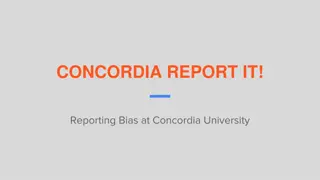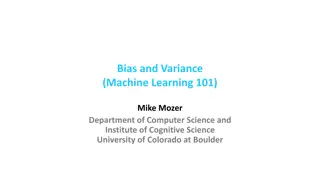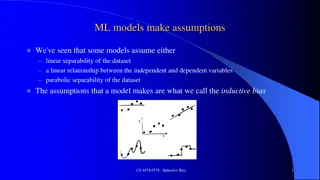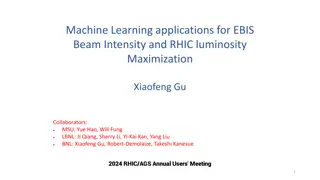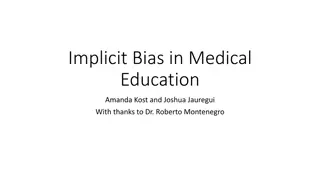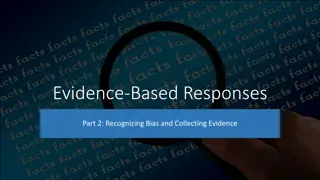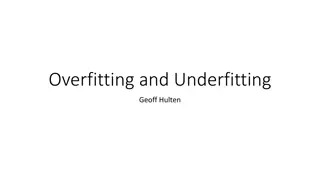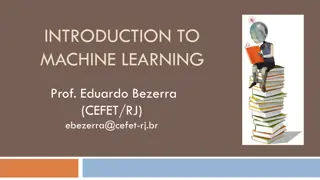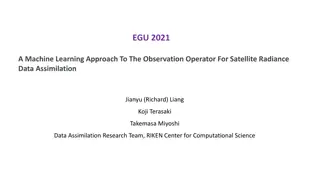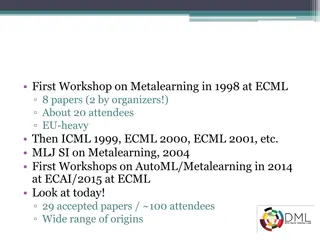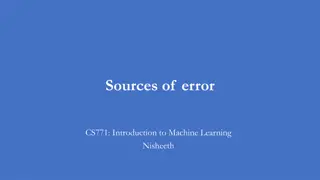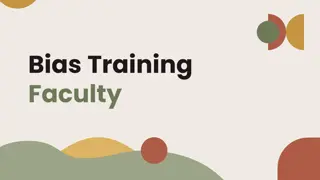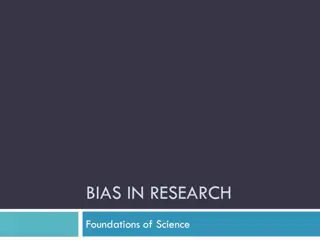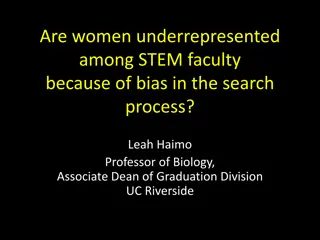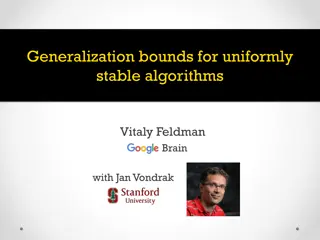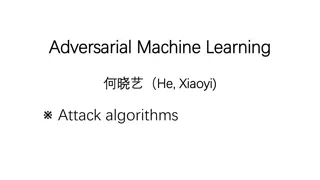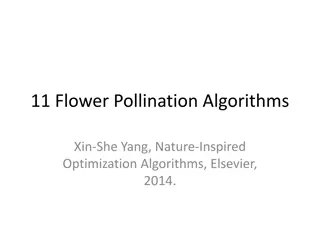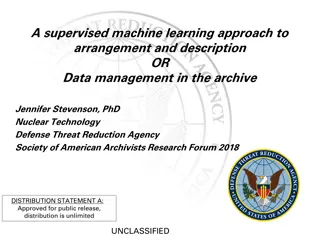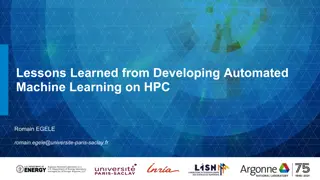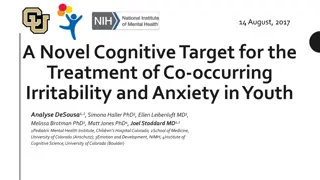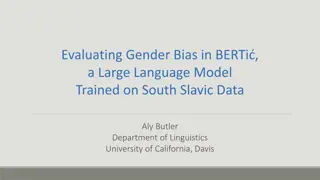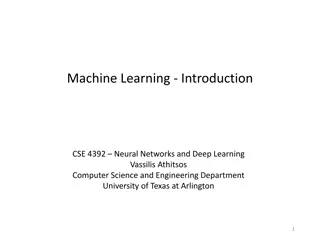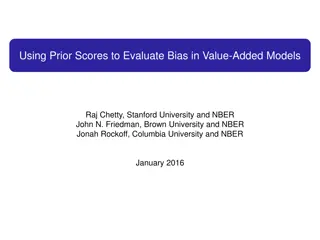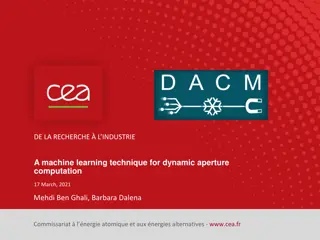Understanding Model Bias and Optimization in Machine Learning
Learn about the concepts of model bias, loss on training data, and optimization issues in the context of machine learning. Discover strategies to address model bias, deal with large or small losses, and optimize models effectively to improve performance and accuracy. Gain insights into splitting training data, overfitting, model complexity, and more for robust model selection.
Download Presentation

Please find below an Image/Link to download the presentation.
The content on the website is provided AS IS for your information and personal use only. It may not be sold, licensed, or shared on other websites without obtaining consent from the author. Download presentation by click this link. If you encounter any issues during the download, it is possible that the publisher has removed the file from their server.
E N D
Presentation Transcript
General Guidance Hung-yi Lee
Framework of ML ??, ?1, ??, ?2, , ??, ?? Training data: ??+?,??+?, ,??+? Testing data: Image Recognition Speech Recognition ?: phoneme ?: ?: ?: soup Speaker Recognition Machine Translation ?: ?: John (speaker) ?: ?:
Framework of ML ??, ?1, ??, ?2, , ??, ?? Training data: Training: Step 1: function with unknown Step 2: define loss from training data Step 3: optimization ? = ???min ? ? = ??? ? ? ? ??+?,??+?, ,??+? Testing data: Use ? = ?? ? to label the testing data ??+1,??+2, ,??+? Upload to Kaggle
loss on training data General Guide large small model bias loss on testing data optimization small large Next Lecture make your model complex overfitting mismatch Not in HWs, except HW 11 more training data (not in HWs) data augmentation make your model simpler trade-off Split your training data into training set and validation set for model selection
Model Bias The model is too simple. ? = ??? ??? ? ??? ? find a needle in a haystack ?? ? but there is no needle ? ? small loss too small Solution: redesign your model to make it more flexible ? = ? + ??1 56 More features ? = ? + ???? ?=1 Deep Learning (more neurons, layers) ? = ? + ?? ??????? ??+ ????? ? ?
loss on training data General Guide large small model bias loss on testing data optimization small large Next Lecture make your model complex overfitting mismatch Not in HWs, except HW 11 more training data (not in HWs) data augmentation make your model simpler trade-off Split your training data into training set and validation set for model selection
Optimization Issue Large loss not always imply model bias. There is another possibility ??? ? ?? ? ??? ? ? ? = ??? ? ? ? ? large A needle is in a haystack ? ? Just cannot find it.
??? ? Model Bias ??? ? find a needle in a haystack ?? ? but there is no needle ? ? small loss too small Which one??? ??? ? ?? ? ??? ? Optimization Issue ? = ??? A needle is in a haystack Just cannot find it. ? ?
Ref: http://arxiv.org/abs/1512.0338 5 Model Bias v.s. Optimization Issue Gaining the insights from comparison Optimization issue Overfitting? Testing Data Training Data
Ref: http://arxiv.org/abs/1512.0338 5 Optimization Issue Gaining the insights from comparison Start from shallower networks (or other models), which are easier to optimize. If deeper networks do not obtain smaller loss on training data, then there is optimization issue. 1 layer 2 layer 3 layer 4 layer 5 layer 2017 2020 0.28k 0.18k 0.14k 0.10k 0.34k Solution: More powerful optimization technology (next lecture)
loss on training data General Guide large small model bias loss on testing data optimization small large Next Lecture make your model complex overfitting mismatch Not in HWs, except HW 11 more training data (not in HWs) data augmentation make your model simpler trade-off Split your training data into training set and validation set for model selection
loss on training data General Guide large small model bias loss on testing data optimization small large Next Lecture make your model complex overfitting mismatch Not in HWs, except HW 11 more training data (not in HWs) data augmentation make your model simpler trade-off Split your training data into training set and validation set for model selection
Overfitting Small loss on training data, large loss on testing data. Why? An extreme example ??, ?1, ??, ?2, , ??, ?? Training data: ??= ? ?? ?????? ?? Less than useless ? ? = ?????? This function obtains zero training loss, but large testing loss.
Overfitting freestyle ? ? Flexible model ? ? ? Large loss Real data distribution (not observable) Training data Testing data ?
Overfitting ? ? Flexible model ? More training data (cannot do it in HWs) ? (you can do that in HWs) Data augmentation
Overfitting ? ? = ? + ?? + ??2 ? constrained model ? ? Real data distribution (not observable) Training data Testing data
Overfitting ? ? = ? + ?? + ??2 ? constrained model ? ? ? Real data distribution (not observable) Training data Testing data ?
Overfitting ? ? = ? + ?? + ??2 ? constrained model ? ? Less parameters, sharing parameters Less features Early stopping Regularization Dropout Fully-connected CNN
Overfitting ? ? = ? + ?? ? constrain too much ? ? ? Back to model bias Real data distribution (not observable) Training data Testing data ?
Bias-Complexity Trade-off loss Testing loss select this one Training loss Model becomes complex (e.g. more features, more parameters)
Homework public private Training Set Testing Set Testing Set Model 1 mse = 0.9 Model 2 mse = 0.7 Model 3 mse > 0.5 May be poor mse = 0.5 Pick this one! The extreme example again ??= ? ?? ?????? ?? ??? = ?: 1 - 10000000000000000000 ?????? It is possible that ?56789?happens to get good performance on public testing set. So you select ?56789? Random on private testing set
Homework public private Training Set Testing Set Testing Set Why? Model 1 mse = 0.9 Model 2 mse = 0.7 Model 3 mse > 0.5 May be poor mse = 0.5 Pick this one! What will happen? http://www.chioka.in/how- to-select-your-final-models- in-a-kaggle-competitio/ This explains why machine usually beats human on benchmark corpora.
Cross Validation How to split? public private Testing Set Training Set Testing Set Training Set Using the results of public testing data to select your model You are making public set better than private set. Validation set Model 1 mse = 0.9 Not recommend Model 2 mse = 0.7 mse > 0.5 Model 3 mse = 0.5 mse > 0.5
N-fold Cross Validation Training Set Model 2 Model 3 Model 1 Train Train Val mse = 0.2 mse = 0.4 mse = 0.4 Train Val Train mse = 0.4 mse = 0.5 mse = 0.5 Val Train Train mse = 0.3 mse = 0.6 mse = 0.3 Avg mse = 0.3 Avg mse = 0.5 Avg mse = 0.4 Testing Set Testing Set public private
loss on training data General Guide large small model bias loss on testing data optimization small large Next Lecture make your model complex overfitting mismatch Not in HWs, except HW 11 more training data (not in HWs) data augmentation make your model simpler trade-off Split your training data into training set and validation set for model selection
Lets predict no. of views of 2/26! 1 layer 2 layer 3 layer 4 layer 2017 2020 0.28k Red: real, Blue: predicted 0.18k 0.14k 0.10k 2/26 2021 0.43k 0.39k 0.38k 0.44k e = 2.58k
loss on training data General Guide large small model bias loss on testing data optimization small large Next Lecture make your model complex overfitting mismatch Not in HWs, except HW 11 more training data (not in HWs) data augmentation make your model simpler trade-off Split your training data into training set and validation set for model selection
Mismatch Your training and testing data have different distributions. Most HWs do not have this problem, except HW11 Be aware of how data is generated. Training Data Simply increasing the training data will not help. Testing Data
loss on training data General Guide large small model bias loss on testing data optimization small large Next Lecture make your model complex overfitting mismatch Not in HWs, except HW 11 more training data (not in HWs) data augmentation make your model simpler trade-off Split your training data into training set and validation set for model selection



